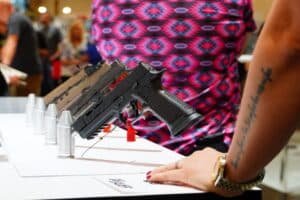New York has made a return appointment for Constitutional scrutiny of their gun-carry laws.
Almost immediately after the Supreme Court struck down the state’s previous law over the subjective nature of its “proper cause” clause, New York is back with a beefed-up and even more subjective “good moral character” clause. In addition to requiring multiple references, the newly-passed standard for issuing gun-carry permits includes a social media review. Instead of relying on objective standards, such as an applicant’s record of convictions or mental health commitments, the state is doubling down on the subjective judgment of its permitting officials.
Instead of judging whether somebody has “proper cause” to carry a gun based on specific threats to their life, state officials will now judge whether or not they are of “good moral character” based on their tweets and Facebook posts. It’s difficult to see how the outcome will be any different.
It’s difficult to see how the legal fight will be any different either. Except, perhaps, how quickly New York loses.
New York is defying the Supreme Court. And it’s not trying to hide that fact.
“With this action, New York has sent a message to the rest of the country that we will not stand idly by and let the Supreme Court reverse years of sensible gun regulations,” Lieutenant Governor Antonio Delgado said in a statement.
New York doesn’t keep statistics on how many gun-carry permits it issues, and estimates vary significantly. The 2021 Crime Prevention Research Center (CRPC) estimate, which is the highest I’ve seen, puts the number at about 195,000 active permits. The same estimate shows its neighbor Pennsylvania, which doesn’t use a subjective “good reason” standard for issuing permits, has over 1,400,000. Florida has over 2,500,000.
CRPC found about ten percent of the population have permits in states that don’t have the unconstitutional “good reason” clause. If New York issued permits at that rate, it would have more than 1,900,000–a tenfold increase.
The Supreme Court clearly intends for the state to come in line with the rest of the country on that front.
“New York is not alone in requiring a permit to carry a handgun in public,” the Court said of New York’s outlier regulations. “But the vast majority of States—43 by our count—are ‘shall issue’ jurisdictions, where authorities must issue concealed-carry licenses whenever applicants satisfy certain threshold requirements, without granting licensing officials discretion to deny licenses based on a perceived lack of need or suitability.”
But New York’s politicians are poised to fight against that eventuality for as long as possible. In fact, they’ve now broadened the battle by passing new restrictions on where those who do get licensed can actually carry. While setting up another showdown over the restrictive nature of their licensing requirements they’ve set up a new one over the restrictive nature of their prohibitions on carrying in “sensitive places.”
Not only does the new law include common prohibitions on guns in areas such as stadiums and courthouses, it makes all businesses presumptively off-limits and requires owners to post signs if they want to allow people to carry inside. It also makes the entirety of Times Square a gun-free zone.
When asked by reporters where permit holders would actually be able to legally carry, Governor Kathy Hochul (D.) responded “probably some streets.”
This is another regulation that seems almost designed to be struck down. The Court directly addressed the idea of “sensitive places” exceptions for gun carry in its ruling. And it made it quite clear a government could not simply designate nearly everywhere a “sensitive place.”
“[E]xpanding the category of ‘sensitive places’ simply to all places of public congregation that are not isolated from law enforcement defines the category of ‘sensitive places’ far too broadly,” the Court wrote. “Respondents’ argument would in effect exempt cities from the Second Amendment and would eviscerate the general right to publicly carry arms for self-defense that we discuss in detail below. Put simply, there is no historical basis for New York to effectively declare the island of Manhattan a ‘sensitive place’ simply because it is crowded and protected generally by the New York City Police Department.”
It’s unlikely the Court would take a different view for effectively declaring the island of Manhattan *except for some public streets* a “sensitive place.” But the entire legislative package in response to the Court’s ruling appears intended to poke the institution in the eye. That includes the express reasoning from Governor Hochul’s press release on why these laws were passed at all.
“Today’s legislative package furthers the State’s compelling interest in preventing death and injury by firearms,” the release said.
Of course, this too flies directly in the face of how the Supreme Court said gun laws would be judged.
“To justify its regulation, the government may not simply posit that the regulation promotes an important interest,” the Court said. “Rather, the government must demonstrate that the regulation is consistent with this Nation’s historical tradition of firearm regulation. Only if a firearm regulation is consistent with this Nation’s historical tradition may a court conclude that the individual’s conduct falls outside the Second Amendment’s ‘unqualified command.'”
None of this means that there aren’t ways in which New York could impose stricter regulations on gun carry than what states including Pennsylvania and Florida have done. Second Amendment jurisprudence is still in its infancy and “sensitive places” exceptions or the limits of objective training and background check standards are not fully fleshed out.
The problem for New York is it appears to have immediately jumped to the least-defensible position in all those areas at the exact same time. The Court gave a significant amount of guidance on what it believes are constitutional restrictions of gun carry, and they don’t align with what New York is pursuing.
“The Second Amendment guaranteed to ‘all Americans’ the right to bear commonly used arms in public subject to certain reasonable, well-defined restrictions,” the Court wrote. “Those restrictions, for example, limited the intent for which one could carry arms, the manner by which one carried arms, or the exceptional circumstances under which one could not carry arms, such as before justices of the peace and other government officials. Apart from a few late-19thcentury outlier jurisdictions, American governments simply have not broadly prohibited the public carry of commonly used firearms for personal defense. Nor, subject to a few late-in-time outliers, have American governments required law-abiding, responsible citizens to ‘demonstrate a special need for self-protection distinguishable from that of the general community’ in order to carry arms in public.”
The politics of losing again and again in court over attempts to restrict guns may not be catastrophic for the politicians pushing these laws as it hasn’t for leaders of other deep-blue areas in the past. But it may well result in even more unfavorable precedents for gun-control advocates.







6 Responses
Stephen, is there any reason to believe that the new New York (and California’s) micro-stamping law, set to take effect sometime after a 6 month research period, will be struck down by the US Circuit Court or SCOTUS? Has anyone started a legal challenge on 2A strict scrutiny grounds?
I am curious how a strict scrutiny interpretation of the 2A will change future rulings on onerous technological requirements for gun ownership in the USA.
Yes, it seems likely to fail Bruen’s text and tradition test. That’s different from strict scrutiny. Instead of balancing government interests against individual rights, the test looks for historical analogs for the modern regulation to determine if it’s constitutional. That doesn’t mean there had to be a microstamping law in 1792, but you’d need to show a law that attempted to track how every gun was used or something along those lines. It has to be a law with similar goals and analogous methods. Think of it like how we treat virtual searches today in regards to the 4th Amendment.
(Pre-Bruen,) I believe the Ninth Circuit used both “two-step” (struck down in Bruen), and “strict scrutiny” (no longer relevant in Bruen) to strike down the 18-21 year old ban. However this was only done to prevent the case from being seen by SCOTUS and frustrate legal review. Or in other words, “tactical mooting”.
However since Bruen nullified the “two-step” and instead dictated “text as informed by history”, in the end, the legal gymnastics and political maneuvering only saved Ninth Circuit from yet another single SCOTUS GVR.
The 18-21-year-old “assault weapons” ban was struck down by a lower court judge in the Ninth Circuit. It hasn’t made it to a full en banc hearing which is where gun laws are usually upheld. So, I don’t think it is an example of the Ninth Circuit trying to keep the case from SCOTUS. But I do think they will start doing that with other cases soon.
That’s the funniest headline I’ve seen in a while
We try not to joke around too much. But sometimes a good headline is a good headline…